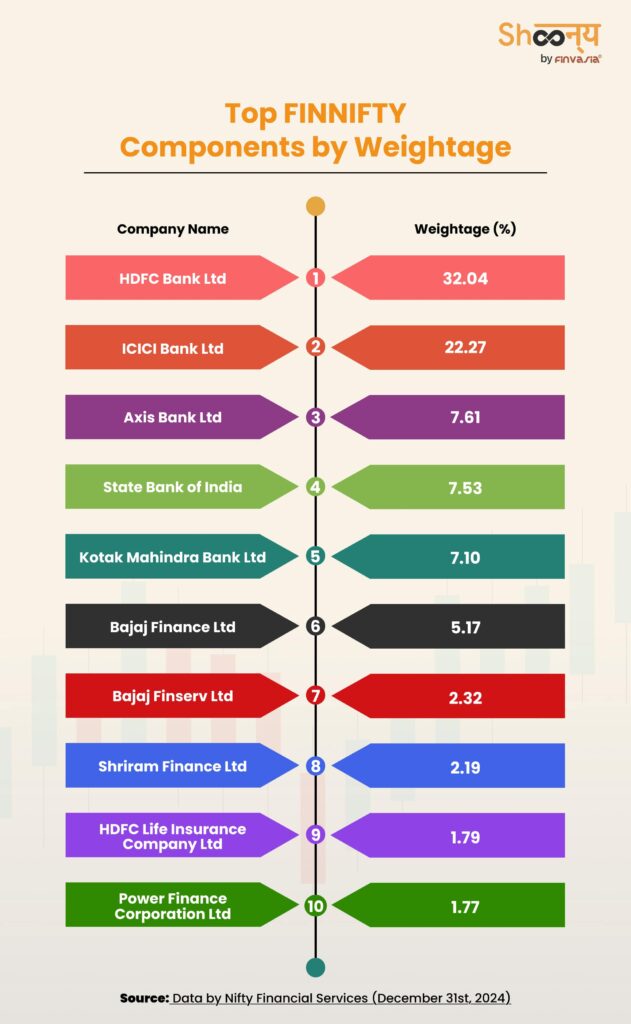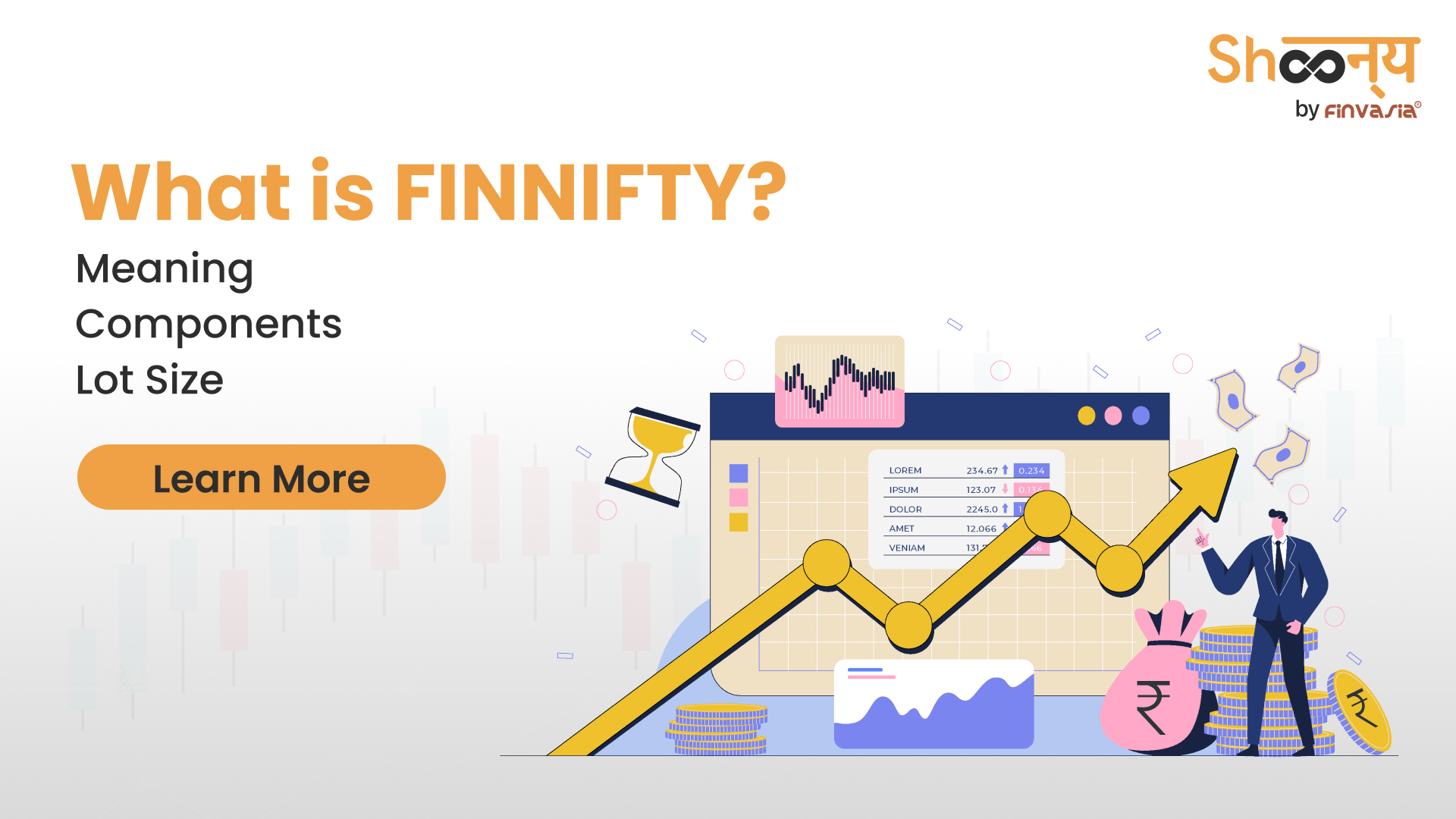India’s financial sector is on an extraordinary growth route, driven by innovation, digital adoption, and rising consumer trust. As per the latest reports, the fintech industry is projected to quadruple to $421 billion by 2029. This growth opens a unique opportunity to capture the sector’s performance efficiently. But how can you track the biggest banks, insurance companies, and financial companies in one place? The answer lies in FINNIFTY. Ready to learn what is Finnifty?
Let’s begin!
In this article, we will explain the Finnifty meaning, Finnifty timings, lot size, and much more!
- What is FINNIFTY?
- What does FINNIFTY track?
- FINNIFTY Components
- How to Trade FINNIFTY Derivatives?
- Difference Between Fin nifty and Nifty
- Difference between FINNIFTY and BankNifty
- Summary of FINNIFTY Historical Performance: 2021- 2024
- Benefits of Investing in FINNIFTY
- Ways of Investing in FINNIFTY
- Conclusion
- FAQs | FINNIFTY
What is FINNIFTY?
FINNIFTY Full Form- The Nifty Financial Services Index measures the performance of the financial services sector in India. It was launched by the National Stock Exchange (NSE) on January 11, 2021, as a part of its efforts to provide more products and opportunities for investors.
The objective of the Nifty Financial Services Index is to mirror the patterns and outcomes of the Indian financial market. It includes banks, financial institutions, housing finance, insurance companies, and other entities in the financial services sector.
Why was FINNIFTY launched?
FINNIFTY was launched to serve the growing demand and interest in banks, insurance companies, non-banking financial companies (NBFCs), housing finance companies, and other financial intermediaries.
1. FINNIFTY provides a benchmark and a trading instrument for the financial services sector.
2. It aims to diversify the product portfolio and enhance the liquidity of the NSE.
3. It is also focused on attracting more domestic and foreign investors, especially institutional investors, who are looking for exposure to the Indian financial sector.
How is FINNIFTY Calculated?
Now that we know the FINNIFTY meaning let’s understand how it is calculated.
Like other stock market indices, FINNIFTY is based on the market capitalisation of the companies included in it.
(Market capitalisation is the total value of a company’s shares in the stock market.)
FINNIFTY uses the free-float market capitalisation method to reflect the actual market performance. This means only the shares available for trading are considered in the calculation. Shares held by promoters or those locked in for other reasons are excluded.
The weightage of each stock in FINNIFTY isn’t fixed; it changes based on market conditions and periodic updates. To ensure that no single stock has too much influence on the index, there’s a limit on how much weight a stock can have. This helps balance the index and ensures fair representation of the financial sector.
What does FINNIFTY track?
FINNIFTY tracks the performance of 20 companies that are part of the financial services sector in India. These companies are selected based on their free-float market capitalisation, trading volume, and turnover.
The index is rebalanced every six months, in June and December, to reflect the changes in the market conditions and the sector composition.
Sectors Involved in Finnifty
The sectors involved in FINNIFTY are banking, insurance, non-banking financial companies (NBFCs), housing finance, and other financial intermediaries.
FINNIFTY Components
Fin nifty comprises 20 stocks across different sectors like banking, housing finance, insurance, and others.
| Company Name | Sector |
| HDFC Bank Ltd | Banking |
| HDFC Ltd | Housing Finance |
| ICICI Bank Ltd | Banking |
| Kotak Mahindra Bank Ltd | Banking |
| Axis Bank Ltd | Banking |
| Bajaj Finance Ltd | NBFC |
| State Bank of India | Banking |
| Bajaj Finserv Ltd | NBFC |
| SBI Life Insurance Co Ltd | Insurance |
| ICICI Prudential Life Insurance Co Ltd | Insurance |
| HDFC Life Insurance Co Ltd | Insurance |
| ICICI Lombard General Insurance Co Ltd | Insurance |
| IndusInd Bank Ltd | Banking |
| Muthoot Finance Ltd | NBFC |
| Cholamandalam Investment & Finance Co Ltd | NBFC |
| AU Small Finance Bank Ltd | Banking |
| Mahindra & Mahindra Financial Services Ltd | NBFC |
| Power Finance Corporation Ltd | NBFC |
| REC Ltd | NBFC |
| Shriram Transport Finance Co Ltd | NBFC |
Here are the top 10 FINNIFTY Components by Weightage, as of Dec 31st, 2024:

How to Trade FINNIFTY Derivatives?
FINNIFTY derivatives are contracts that derive their value from the underlying FINNIFTY index. There are two types of derivatives available for trading on the NSE: futures and options.
Futures are contracts that oblige the buyer to buy or the seller to sell the underlying asset at a predetermined price & date in the future.
Options are contracts that give the buyer the right, without an obligation, to buy/ sell the underlying asset at a predetermined price & date in the future.
FINNIFTY futures and options have the following features:
• Contract size: The value of FINNIFTY futures contracts must be at least Rs. 5 lakhs upon introduction. The permitted lot size for both futures and options contracts will be the same for a
• Settlement method: The settlement method of FINNIFTY futures and options is cash settlement, which means that the difference between the contract price and the final settlement price is paid or received in cash.
FINNIFTY Expiry Time and Date
The expiry time of FINNIFTY futures and options contracts is 3:30 PM (IST), which is the closing time of the National Stock Exchange (NSE).
The expiry day of FINNIFTY futures and options contracts is the last Tuesday. For monthly contracts, the expiry date falls on the last Tuesday of the month, whereas for weekly contracts, it is set for the Tuesday of the week in which it is meant to expire. If the last Tuesday is a trading holiday, then the previous trading day is considered the FINNIFTY expiry day.
FINNIFTY Lot Size
The lot size of FINNIFTY futures and options contracts is 40. The lot size is set by the National Stock Exchange (NSE) and may vary based on market conditions.
Difference Between Fin nifty and Nifty
Here’s a quick overview of the difference between Finnifty and Nifty:
| Finnifty | Nifty |
| Tracks the performance of 20 leading financial companies listed on the NSE | Tracks the performance of 50 large and liquid companies across various sectors listed on the NSE |
| Launched in September 2011 with a base value of 1000 and a base date of January 1, 2004 | Launched in April 1996 with a base value of 1000 and a base date of November 3, 1995 |
| More focused on the financial sector, which includes banks, NBFCs, insurance firms, housing finance firms, and other financial services | More diversified across different sectors, such as IT, energy, consumer goods, pharma, metals, etc. |
Difference between FINNIFTY and BankNifty
BankNifty is ideal for those who want to focus on the banking sector, while FINNIFTY is better suited for investors seeking broader exposure to the financial services industry with reduced sector-specific risks.
| Basis | BankNifty | FINNIFTY |
| Sectoral Coverage | Focuses only on banks. | Covers banks, insurance companies, NBFCs, and other financial institutions. |
| Diversification | Limited diversification as it tracks only the banking sector. | Broad diversification across various financial services sectors. |
| Risk Profile | Higher sector-specific risks, such as loan defaults or regulatory changes. | Lower risk due to diversification, reducing the impact of negative events in one segment. |
| Focus Area | Banking sector performance. | Overall financial services sector performance. |
| Exposure | Narrow, ideal for banking-focused investors. | Wider, suitable for investors seeking diverse financial exposure. |
Summary of FINNIFTY Historical Performance: 2021- 2024
As per the latest data released by NSE, these figures offer a simplified view of how FINNIFTY has performed over the recent periods:
- In the last quarter, FINNIFTY saw a gain of 8.46%.
- Year-to-date, the growth is at 13.20%.
- Looking back one year, it’s been a consistent 13.20% climb.
- Over the past 5 years, the average annual growth has been 13.15%.
- Since its inception 5 years ago, the total growth has been 16.57%.
Considering the overall returns:
- In the last quarter, the total return was 8.52%.
- Year-to-date, investors have seen a total growth of 14.31%.
- Looking back one year, the total returns stand at 14.31%.
Benefits of Investing in FINNIFTY
FINNIFTY provides exposure to the financial services sector:
- FINNIFTY offers portfolio diversification, as it consists of 20 stocks from various sub-sectors and segments of the financial services sector. The index also has a low correlation with other indices, such as Nifty 50, Nifty Bank, and Sensex, which means that it can reduce the overall risk and volatility of the portfolio.
- FINNIFTY is the first sectoral index in India to have weekly expiry contracts. The weekly contracts allow investors to trade more frequently, hedge their positions, and take advantage of short-term market movements.
Ways of Investing in FINNIFTY
The first step to investing in FINNIFTY is to open a free demat account. Once done, you can explore three different ways of investing in FINNIFTY: ETFs, index funds, and direct investment in FINNIFTY stocks.
- ETFs (Exchange-Traded Funds): ETFs track the performance of an underlying index, such as FINNIFTY, and trade on the stock exchange like shares. They offer low-cost, passive, and transparent investment in FINNIFTY.
- Direct Investment in FINNIFTY Stocks: This involves buying the shares of the 20 companies that are part of FINNIFTY in the same proportion as their weightage in the index. Direct investment offers active, customised, and flexible investment in FINNIFTY.
- Index Funds: Index funds replicate the portfolio of an underlying index, such as FINNIFTY, and aim to match its returns. They offer low-cost, passive, and diversified investments in FINNIFTY.
Conclusion
FINNIFTY is a new and innovative index that provides comprehensive and diversified exposure to the financial services sector in India. FINNIFTY has shown impressive performance and returns over time. If you are looking for a way to invest in the financial sector, FINNIFTY derivatives could be a suitable option for you.
FAQs | FINNIFTY
There are 20 stocks in FINNIFTY, representing various sectors like banks, insurance, housing finance, NBFCs, and other financial services companies.
FINNIFTY consists of 20 stocks focused on the financial services sector, while Nifty 50 has 50 stocks across diverse sectors, reflecting the broader market sentiment.
When FINNIFTY contracts expire, they are settled in cash based on the final settlement price of the underlying index. Investors settle the difference between the contract price and the final settlement price, and they can choose to roll over their positions to the next expiry cycle if they wish to continue their exposure.
The expiry day of FINNIFTY futures and options contracts is the last Tuesday. For monthly contracts, the expiry date falls on the last Tuesday of the month, whereas for weekly contracts, it is set for the Tuesday of the week in which it is meant to expire. If the last Tuesday is a trading holiday, then the previous trading day is considered the FINNIFTY expiry day.
As of November 29, 2024, the top five stocks in FINNIFTY by weightage are HDFC Bank Ltd. (33.48%), ICICI Bank Ltd. (22.51%), Axis Bank Ltd. (7.96%), State Bank of India (7.93%), and Kotak Mahindra Bank Ltd. (6.37%).
FINNIFTY, or the Nifty Financial Services Index, tracks the performance of 20 leading financial companies in India, including banks, insurance firms, and NBFCs. It helps investors monitor the financial services sector.
Yes, you can invest in FINNIFTY through ETFs, index funds, or by directly buying shares of the companies included in the index.
Source- nseindia.com, niftyindices.com
______________________________________________________________________________________
Disclaimer: Investments in the securities market are subject to market risks; read all the related documents carefully before investing.

